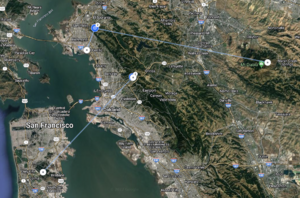Bay Area Backbone
The goal of the Bay Area Backbone Project is to provide a fast, IP microwave based networking between amateur high sites in the Bay Area. The backbone provides IP connectivity within the network and can provide public IPv4 address for full Internet connectivity when required.
The network is available to any amateur operator needing connectivity to, from or between supported sites.
Hosted Projects
- Bay Area Mesh (AREDN)
Sites
Detailed site configuration can be found here.
- Black Mountain (Site 4) - Los Altos Hills (pending)
- Fire Station 8 - Palo Alto (pending)
- Fish Ranch - Oakland Hills
- ORCA - Oakland Hills
- San Bruno Mountain (Building 4) - Brisbane
- San Bruno Mountain (Building 7) - Brisbane
- Sunol Ridge - Sunol Peak
- Wolfback - Marin Headlands
- Mount Allison (pending)
Want to become part of the network? We'll provide everything you need to get connected.
ARIN
American Registry for Internet Numbers
Organizations
Points of Contact
- TECH1410-ARIN - Tech
- WILKI322-ARIN - General
Networks
- NET-206-197-44-0-1 - 206.197.44.0/24
- NET6-2620-B8-A000-1 - 2620:B8:A000::/48
Autonomous System Numbers
Backbone Network Structure
Radios
A minimal backbone endpoint consists of two radios providing a point-to-point link between two sites. Generally Ubiquiti airFiber 5XHD radios are used. In some cases a point-to-multipoint setup is used (generally where tower space is limited). In these cases we use the Ubiquiti LTU-Rocket to provide the multipoint target, with 5XHD radios (with alternate firmware) at the other ends.
Routers
Any router capable of supporting OSPF can be used to support the radios. We currently deploy the following:
- Ubiquiti EdgeRouterX
- Ubiquiti EdgeRouterX SFP
- Mikrotik CRS112-8P-4S.
- Mikrotik CHR
Software
The backbone network runs OSPF internally and BGP externally.
Backbone Links
Active
- Fish Ranch
- ORCA
- CCCC
- San Bruno Mountain (Building 4)
- San Bruno Mountain (Building 7)
- Fish Ranch
- San Carlos
- Swallow
- San Carlos
- Sunol Ridge
- Swallow
- Mount Diablo
- Richmond Field Station
- Wolfback
- ORCA
- Oxford
- Oxford
Planned
Proposed
Peering and IP Transit
The backbone network uses two IP Transits points to facilitate access to and from the public Internet using BGP.
- FreeRangeCloud BGP Tunnel (Fremont)
- Route64.org (Kansas City)
Peering Information
History
The first backbone link, between Fish Ranch and San Bruno Mountain, was installed on the 23rd November, 2021 and became operational on 3rd September, 2022. The goal was to provide a solid connection across the Bay which the AREDN network could use. It had been observed by the AREDN network builders in Southern California, that a better quality and more stable network could be constructed by creating a solid, well engineered backbone, to which local community AREDN networks could connect.
Bay Area Mesh on the Backbone
Using the Bay Area Backbone to support the Bay Area Mesh has a number of advantages for the Mesh:
- It easier to connect high sites to other high sites, especially when we're trying to connect different neighborhoods while avoiding mountain ridges.
- High sites are often backed up with generator power. We provide battery backup ourselves, but that will only last so long.
- High sites will be there when the Ham moves on. Because these are generally commercial sites with long histories of ham involvement, we are not a the whims of someones current housing situation or - in some cases - employment situation.
- It's often easier for a neighborhood to connect up to a high site (or more than one) as they're less obstructed.
Status
The current health of the backbone is monitored here (internet)
Hardware
The mesh operates on the Backbone by creating point-to-point VLANs between mesh sites (these are called xlinks - see below). Mikrotik hAP ac2 nodes provide the the mesh endpoint hardware. The VLANs are passed across specific backbone links and traffic is not flooded across the backbone.
XLINKS
XLINKS are custom VLANs between sites which feed directly into the AREDN router. Think of them as DtD links, but only point-to-point.
| Link | VLAN | A | B | Notes |
|---|---|---|---|---|
| San Bruno Mountain to Swallow | 10 | 100.64.0.21 | 100.64.0.22 | |
| ORCA to Wolfback | 11 | 100.64.0.17 | 100.64.0.18 | |
| ORCA to Fish Ranch | 12 | 100.64.0.13 | 100.64.0.14 | |
| Fish Ranch to San Bruno Mountain (7) | 13 | 100.64.0.10 | 100.64.0.9 | |
| San Carlos to Sunol Ridge | 14 | 100.64.0.6 | 100.64.0.5 | |
| San Bruno Mountain to San Carlos | 15 | 100.64.0.1 | 100.64.0.2 | |
| San Bruno Mountain to Fire Station 8 | 16 | 100.64.0.25 | 100.64.0.26 | |
| Fire Station 8 to Mount Allison | 17 | 100.64.0.29 | 100.64.0.30 | Subject to change as site uses VLANs extensively |
| Oxford to Wolfback | 18 | 100.64.0.33 | 100.64.0.34 | |
| Fish Ranch to San Bruno Mountain (4) | 19 | 100.64.0.37 | 100.64.0.38 | |
| San Bruno Mountain (7) to Black Mountain | 20 | 100.64.0.41 | 100.64.0.42 |
Backbone links appear in the mesh labeled as xlink but are no different from any other link in the network. We are not building a hierarchy with the backbone at the top and the rest of the mesh hanging below. But the nature of the backbone, how it connects, and the way the mesh routing protocol operates, these links will provide preferred pathways between physically distance locations.
Contacts
- Tim Wilkinson - KN6PLV - tim@sfwem.net
